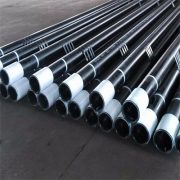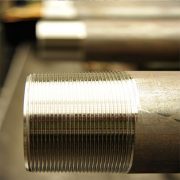Threads of Casing Pipe: STC, LTC and BTC
Casing pipes are an essential component in the oil and gas drilling process. They provide structural integrity to the wellbore and prevent unwanted fluids from entering the well. One critical aspect of casing pipe design is the threading, which plays a key role in joining the pipes together securely and ensuring a leak-free connection. The three most common types of casing threads are Short Threaded Coupling (STC), Long Threaded Coupling (LTC), and Buttress Threaded Coupling (BTC). Each thread type has its own distinct design features, applications, and performance characteristics. In this blog, we’ll explore these thread types, their advantages, and how they address industry-specific needs.
1. Introduction to Casing Pipe Threads
Casing pipes are threaded at both ends, allowing for the secure attachment of one pipe to another. This ensures that the casing string remains intact while it is lowered into the wellbore. The thread type used depends on the specific well conditions, depth, pressure, and geological formations encountered during the drilling process.
The casing threads are designed to:
- Provide leak-tight seals.
- Withstand high pressures and loads.
- Facilitate easy makeup (assembly) and breakout (disassembly).
- Prevent pipe failures due to tension, compression, or torque forces.
Let’s take a closer look at the three most common types of casing pipe threads: STC, LTC, and BTC.
2. Short Threaded Coupling (STC)
Short Threaded Coupling (STC) is one of the most common thread designs for casing pipes, particularly in shallow wells where moderate pressures and forces are expected.
2.1. Design and Features
- Thread Length: STC threads are relatively short, which makes them easier to manufacture and assemble.
- Thread Profile: The threads are generally of a tapered design, which improves sealing by tightening the connection as torque is applied.
- Coupling Design: STC connections use a coupling to join two sections of casing pipe. The short thread length means the coupling itself is relatively short, reducing the overall weight of the casing string.
2.2. Applications
STC threads are commonly used in:
- Shallow wells: Where pressures are lower and the demands on the casing string are less severe.
- Low-cost drilling operations: STC is more cost-effective compared to longer threaded designs due to simpler manufacturing and easier assembly.
- Onshore oil fields: Where the environmental conditions are less extreme.
2.3. Advantages and Disadvantages
Advantages:
- Easy and quick to assemble.
- Cost-effective.
- Lightweight, reducing the load on the rig.
Disadvantages:
- Limited load-bearing capacity, making it unsuitable for deeper wells.
- Less resistance to high pressures and extreme well conditions.
3. Long Threaded Coupling (LTC)
Long Threaded Coupling (LTC) offers a stronger, more secure connection compared to STC, making it ideal for deeper wells where higher pressures and more demanding conditions are present.
3.1. Design and Features
- Thread Length: LTC threads are significantly longer than STC, providing a more robust connection.
- Thread Profile: LTC threads also feature a tapered design, which enhances the sealing capability as torque is applied.
- Coupling Design: The coupling used in LTC connections is longer, which adds strength and enhances the connection’s ability to withstand the mechanical loads experienced in deeper wells.
3.2. Applications
LTC threads are typically used in:
- Intermediate-depth wells: Where pressures and forces are moderate to high, but not extreme.
- Onshore and offshore drilling: Especially in environments where the casing may be subjected to additional mechanical stresses.
- Moderate-cost operations: LTC provides a good balance of strength and cost-efficiency.
3.3. Advantages and Disadvantages
Advantages:
- Higher load-bearing capacity compared to STC.
- Better suited for deeper wells and higher pressures.
- Reliable sealing properties.
Disadvantages:
- More complex and time-consuming to assemble due to the longer thread length.
- Slightly more expensive than STC threads.
4. Buttress Threaded Coupling (BTC)
Buttress Threaded Coupling (BTC) is the strongest and most robust of the three thread types, designed for extreme environments, high pressures, and deep wells. BTC threads are designed with a larger surface area for load-bearing, making them ideal for highly demanding applications.
4.1. Design and Features
- Thread Profile: Unlike STC and LTC, BTC threads have a square or near-square profile. This design increases the surface area of the thread, distributing loads more effectively across the connection.
- Thread Length: BTC threads can be similar in length to LTC threads, but the square design significantly enhances their strength and load-bearing capacity.
- Coupling Design: BTC uses large couplings that can support extreme forces and prevent thread failures in the well.
4.2. Applications
BTC threads are used in:
- Deep and ultra-deep wells: Where the pressures and mechanical stresses are extremely high.
- Offshore oil fields: Particularly in high-pressure, high-temperature (HPHT) wells.
- Critical drilling operations: Where failure is not an option, and the casing must withstand extreme conditions over long periods.
4.3. Advantages and Disadvantages
Advantages:
- Exceptional load-bearing capacity.
- High resistance to pressure and torque forces.
- Suitable for the most challenging drilling environments, including HPHT wells.
Disadvantages:
- More expensive to manufacture and install due to the complexity of the thread design.
- Requires more time and expertise to assemble and break out.
5. Comparing STC, LTC, and BTC Threads
Each thread type has its own strengths and limitations, which makes them suitable for different well conditions and depths. Here’s a quick comparison:
| Feature | STC | LTC | BTC |
|---|---|---|---|
| Thread Length | Short | Long | Long (Square Profile) |
| Strength | Low to Moderate | Moderate to High | High to Very High |
| Pressure Resistance | Moderate | High | Very High |
| Typical Applications | Shallow wells, low-pressure | Intermediate-depth wells | Deep wells, HPHT environments |
| Cost | Low | Moderate | High |
6. Selecting the Right Casing Thread for Your Application
When choosing a casing pipe and thread type, several factors should be considered, including:
- Well Depth: Deeper wells require stronger threads like LTC or BTC.
- Pressure and Temperature: High-pressure, high-temperature wells typically demand the robustness of BTC threads.
- Cost Considerations: While STC threads are cheaper, they may not offer the necessary strength and durability for deeper or more complex wells.
- Well Environment: Offshore or environmentally demanding wells may benefit from the added strength and sealing capability of LTC or BTC threads.
7. Conclusion
The choice and threads of casing pipe—STC, LTC, or BTC—depend on the specific demands of the drilling environment. STC threads offer a cost-effective solution for shallow wells, LTC threads provide greater strength for intermediate-depth applications, and BTC threads deliver maximum strength and durability for deep wells and extreme conditions. By understanding the differences between these thread types, engineers and drilling teams can select the most appropriate casing for their projects, ensuring the safety and efficiency of oil and gas production.
Whether you are drilling shallow onshore wells or deep offshore wells, choosing the right thread type is crucial to the long-term success of the operation.
FUTURE ENERGY STEEL can fabricate STC, LTC, and BTC according to API 5CT, what’s more, our factory also can produce BT-1, BT-2, and BT-3 which can substitute for special threads, such as New VAM and VAM top.





